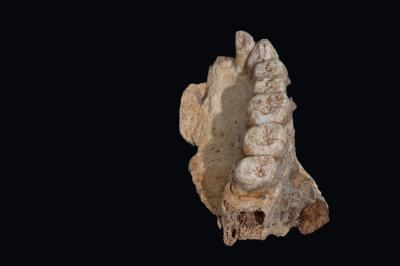Israel Fossil Discovery Pushes Human Migration From Africa Back By 55,000 Years

A partial jawbone, with some teeth still attached to it, is quite literally changing human history. Or, to be more accurate (and less dramatic), it is changing our understanding of human history and how we modern humans evolved in Africa and moved out of there.
It is commonly known that Home sapiens first came around in Africa, and then, over time, migrated outward, intermixing with or exterminating local populations of other human species they came across in their travels, gradually becoming the only humans left on the planet. The first wave of migration of Homo sapiens, as evidenced by fossil finds in places outside Africa, was thought to have taken place a maximum of 120,000 years ago.
That date was based on fossils found in Skhul and Qafzeh caves in Israel, which were dated to between 90,000 and 120,000 years ago. But the discovery of another Homo sapiens fossil — “an upper jawbone with several teeth” — from a site called Misliya cave, also in Israel, has pushed back the date of human migration significantly — a whopping minimum of 55,000 years. The fossil has been dated to be 177,000-194,000 years old.
Now the earliest-known modern human fossil found outside Africa (the oldest modern human fossil discovered so far is about 300,000 years old and was found in modern-day Morocco), it was discovered by a large international team of researchers, led by Israel Hershkovitz from Tel Aviv University. They described their find in a paper published Thursday in the journal Science.
“Misliya is an exciting discovery. It provides the clearest evidence yet that our ancestors first migrated out of Africa much earlier than we previously believed. It also means that modern humans were potentially meeting and interacting during a longer period of time with other archaic human groups, providing more opportunity for cultural and biological exchanges,” Rolf Quam, an anthropology professor at Binghamton University, State University of New York, and a coauthor of the study, said in a statement.
Some features of the Misliya fossil resemble those of other human species, such as Neanderthals. That suggests some modern human features evolved outside Africa, or were maybe even acquired from other species, the researchers said.
“Our research makes sense of many recent anthropological and genetic finds. About a year ago, scientists reported finding the remains of modern humans in China dating to about 80,000-100,000 years ago. This suggested that their migration occurred earlier than previously thought, but until our discovery at Misliya, we could not explain it. Numerous different pieces of the puzzle — the occurrence of the earliest modern human in Misliya, evidence of genetic mixture between Neanderthals and humans, modern humans in China — now fall into place,” Hershkovitz said in another statement.
That some modern human features evolved long after Home sapiens first showed up has been proven earlier, such as by the fact that the human brain has changed in shape from 300,000 years ago to as recently as 35,000 years ago.
The research paper was titled, rather simply, “The earliest modern humans outside Africa.”
© Copyright IBTimes 2024. All rights reserved.



















